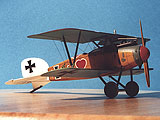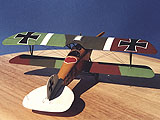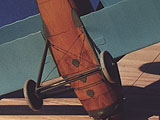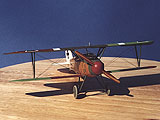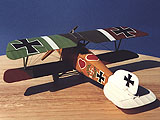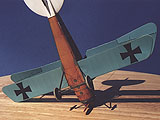Albatros D.III in Voss' markings
1/48 Eduard
By: Tomasz Gronczewski
Werner Voss | the model |
construction | the gallery
| links
Werner Voss
|
The man
|
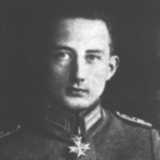
|
Werner Voss is an ace who deserves a book rather than
a couple of paragraphs on the construction page. All interested in Voss'
career should visit a website at the address http://blindkat.tripod.com/voss/voss.html,
which is entirely devoted this outstanding pilot.
Werner Voss started war as a hussar on the Eastern Front,
but in Autumn 1915 he joined aviation and fought with FEA 7 and KG 4.
On November 21st 1916, a month after Boelcke's death, Voss joined Jasta
2. Until early May of 1917 he scored 28 victories, and then moved to
Jasta 5 to score further 6 kills. All his early kills were scored with
Albatros scout. In summer he was acted temporarily as a commander of
Jasta 29, later Jasta 14, but failed to down any enemy with these outfits.
On July 30th 1917 Voss was nominated Jastaführer of Jasta 10. During
two months he scored further 14 victories, mainly with a new Fokker
F.I Dreidecker, but on September 23rd, after bringind down his last
48th victim, he was fell into a trap prepared by 56th Sqn RFC and was
killed by British pilots after epic dogfight. Mortal bullet was shot
by an ace Arthur Rhys Davis.
Until the end of war Werner Voss remained fourth ranking
German ace. In February and March 1917 he was leading German scorer
with 8 and 11 victories respectively. Since then and until his death
he had been continuously a second best living German ace after Manfred
von Richthofen. It has been confirmed that he downed at least
two RFC aces: Capt N W W Webb (14 victories) on August 16th 1917 and
Lt O L McMaking (6 victories) on September 11th 1917.
|
|
|
and the machine
|
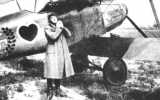
|
Except of Voss' famous Fokker F.I, his Albatros D.III
belongs probably to best know German scouts of the Great War. It was
early production D.III with centrally located wing radiator and some
extra air scoops around the cowling. It bore extremely colorful finish
with red heart and white swastika boldly marked on the fuselage. Voss
adopted this plane while fighting with Jasta 2, what can be witnessed
by a white tail. Nevertheless after his assignment to Jasta 5, he brought
his beloved machine with him and flew it on without major change of
markings.
|
Werner Voss’ scoreboard
| 1. |
Nov 27th 1916 |
Nieuport Scout (A281 of 60 RFC) |
Miraumont |
Jasta 2 |
| 2. |
Nov 27th 1916 |
DH2 (no. 4915 of 18 RFC) |
S Bapaume |
Jasta 2 |
| 3. |
Dec 21st 1916 |
BE2d (5782 of 7 RFC) |
Miraumont |
Jasta 2 |
| 4. |
Feb 1st 1917 |
DH2 (A2614 of 29 RFC, Capt A F V Daly) |
Essarts |
Jasta 2 |
| 5. |
Feb 4th 1917 |
BE2d (No. 5797 of 16 RFC) |
Givenchy |
Jasta 2 |
| 6. |
Feb 10th 1917 |
DH2 (A2548 of 32 RFC) |
SW Serre |
Jasta 2 |
| 7. |
Feb 25th 1917 |
DH2 (A2557 of 29 RFC) |
St. Sauveur |
Jasta 2 |
| 8. |
Feb 25th 1917 |
DH2 (29 RFC) |
Arras |
Jasta 2 |
| 9. |
Feb 26th 1917 |
BE2c (No. 2535 of 16 RFC) |
Ecurie |
Jasta 2 |
| 10. |
Feb 27th 1917 |
BE2c (No. 2530 of 8 RFC) |
Blaireville |
Jasta 2 |
| 11. |
Feb 27th 1917 |
BE2c (No. 7197 of 12 RFC) |
St. Catherine |
Jasta 2 |
| 12. |
Mar 4th 1917 |
BE2d (No. 6252 of 8 RFC) |
S Berneville |
Jasta 2 |
| 13. |
Mar 6th 1917 |
DH2 (No. 7941 of 32 RFC) |
Favreuil |
Jasta 2 |
| 14. |
Mar 11th 1917 |
FE2b (No. 7685 of 22 RFC) |
Combles |
Jasta 2 |
| 15. |
Mar 11th 1917 |
Nieuport Scout (A279 of 60 RFC) |
Baillcul |
Jasta 2 |
| 16. |
Mar 17th 1917 |
FE2b (11 RFC) |
NE Warlemont |
Jasta 2 |
| 17. |
Mar 17th 1917 |
DH2 (A2583 of 32 RFC) |
SW Bapaume |
Jasta 2 |
| 18. |
Mar 18th 1917 |
BE2d (No. 5784 of 8 RFC) |
Neuville |
Jasta 2 |
| 19. |
Mar 18th 1917 |
BE2d (No. 2755 of 4 RFC) |
Boyelles |
Jasta 2 |
| 20. |
Mar 19th 1917 |
RE8 (A4165 of 59 RFC) |
St. Leger |
Jasta 2 |
| 21. |
Mar 24th 1917 |
FE2b (11 RFC) |
SE St. Leger |
Jasta 2 |
| 22. |
Mar 24th 1917 |
BE2d (No. 5777 of 16 RFC) |
SE Mercatel |
Jasta 2 |
| 23. |
Apr 1st 1917 |
BE2c (No. 2561 of 15 RFC) |
E St. Leger |
Jasta 2 |
| 24. |
Apr 6th 1917 |
BE2e (A3157 of 15 RFC) |
S Lagnicourt |
Jasta 2 |
| 25. |
May 7th 1917 |
SE5 (A4867 of 56 RFC) |
Etaing |
Jasta 2 |
| 26. |
May 9th 1917 |
BE2e (No. 7209 of 52 RFC) |
Havrincourt |
Jasta 2 |
| 27. |
May 9th 1917 |
Pup (A6174 of 54 RFC) |
Lesdain |
Jasta 2 |
| 28. |
May 9th 1917 |
FE2b (No. 4991 of 22 RFC) |
Le Bosquet |
Jasta 2 |
| 29. |
May 23rd 1917 |
FE2b (A5502 of 18 RFC) |
N Havrincourt |
Jasta 5 |
| 30. |
May 26th 1917 |
Pup (A6168 of 54 RFC) |
SW Gouzeaucourt |
Jasta 5 |
| 31. |
May 28th 1917 |
FE2d (25 RFC) |
SE Douai |
Jasta 5 |
| 32. |
Jun 4th 1917 |
Pup (B2151 of 54 RFC) |
Aubenscheul-aux-Bois |
Jasta 5 |
| 33. |
Jun 5th 1917 |
FE2b (A857 of 22 RFC) |
N Vaucelles |
Jasta 5 |
| 34. |
Jun 6th 1917 |
Nieuport Scout (N3204 of 6 RNAS) |
W Graincourt |
Jasta 5 |
| 35. |
Aug 10th 1917 |
Spad XIII (Spa.31) |
S Dixmude |
Jasta 10 |
| 36. |
Aug 15th 1917 |
FE2d (20 RFC) |
Zillebeke Lake |
Jasta 10 |
| 37. |
Aug 16th 1917 |
Camel (B3756 of 70 RFC, N.W.W. Webb) |
St. Julien |
Jasta 10 |
| 38. |
Aug 23th 1917 |
Spad |
SW Dixmude |
Jasta 10 |
| 39. |
Sep 3rd 1917 |
Camel (B3917 of 45 RFC) |
N Houthem |
Jasta 10 |
| 40. |
Sep 5th 1917 |
DH5 (A9374 of 32 RFC) |
St. Julien |
Jasta 10 |
| 41. |
Sep 5th 1917 |
Caudron |
Bixschoote |
Jasta 10 |
| 42. |
Sep 6th 1917 |
FE2d (B1895 of 20 RFC) |
SE Boesinghe |
Jasta 10 |
| 43. |
Sep 10th 1917 |
Camel (B3787 of 70 RFC) |
Langemarck |
Jasta 10 |
| 44. |
Sep 10th 1917 |
Camel (B3927 of 70 RFC) |
SW Poelcapelle |
Jasta 10 |
| 45. |
Sep 10th 1917 |
Spad (Spa.37) |
E Langemarck |
Jasta 10 |
| 46. |
Sep 11th 1917 |
BF2b (B1105 of 22 RFC) |
Langemarck |
Jasta 10 |
| 47. |
Sep 11th 1917 |
Camel (B6236 of 45 RFC, Lt O.L. McMaking) |
E St. Julien |
Jasta 10 |
| 48. |
Sep 23rd 1917 |
DH4 (A7643 of 57 RFC) |
S Roulers |
Jasta 10 |
Sources:
The model
Although it was my first model of D.III which provided me with
some experience before starting Ray's and Allmenröder's project, I will not
describe its construction in a detailed way. Simply construction process was
very similar to this done at Ray's project.
Below you can find only these steps which were unique.
construction
Nose air scoops:
Despite I worked with Profipack kit, which had PE parts for nose
air scoops, I decided to scratchbuild them. I made them out of thin plexi sheet,
which had been heated over a candle and molded with a rounded tip of the brush.
After cutting the scoops out I just glued them to the nose.
Three color scheme:
In March 1917, when Voss was still within Jasta 2, his Albatros
carried three color scheme of Dark Olive Green / Red Brown / Pale Green. Later,
after the aircraft was taken by Voss to Jasta 5, red brown fields in camouflage
might have been overpainted with violet or purple. In order to avoid any doubts
I decided to make this Albatros as it was in March 1917. I used three ready
Humbrol colors to apply camouflage:
Finally two white stripes were sprayed with Tamiya Gloss white
after masking them with Tamiya masking tape.
Bottom surfaces of the wings were painted with a Humbrol mixture (8 x H 65
Matt Aircraft Blue + 1 x H 48 Mediterranean Blue)
Woodgrain:
I don't know who (Bob Laskodi?) invented clear yellow overcoat
to simulate shellac but he was a genius. It is simply the best technique I have
ever tried, but let us move back to the earlier stage.
First I sprayed all "plywood" areas with Humbrol 121
Stone color. After a night I drew first woodrgrain pattern using red brown color
pencil (crayon). Then I smeared the pattern with a finger in order to break
homogenous sand background color. Later I started to draw final pattern using
red brown, light brown and white pencils. Panel line were darkened with red
brown pencil as well. The technique was so nice that all the time I had to resist
temptation to overdo pattern, which was supposed to simulate plywood only. After
all woodgrain had been done I oversprayed it with a mixture of Tamiya Clear
Yellow + Tamiya Clear Orange. Finally a coat of Future prepared ground for further
decal application. Having decals applied I gave a fuselage a shot of Aeromaster
Flat Clear + Future mixture. Although the photo is darker and a bit redder than
real thing, the idea of the technique can be seen below:
"Metal" panels and elements:
I made the kit before I had collected more photos, and I decided
to paint "metal" surfaces with Humbrol 31 Gray Green. Now, If I started
the model again, I would choose lighter Humbrol 64 Gray.
The gallery
Three color scheme, natural plywood simulation and flamboyant
markings provided me with a lot of fun while building this kit:
Other Cookup pages of Tomasz Gronczewski
Franz Ray | Karl
Allmenröder | cookup subjects comparison


